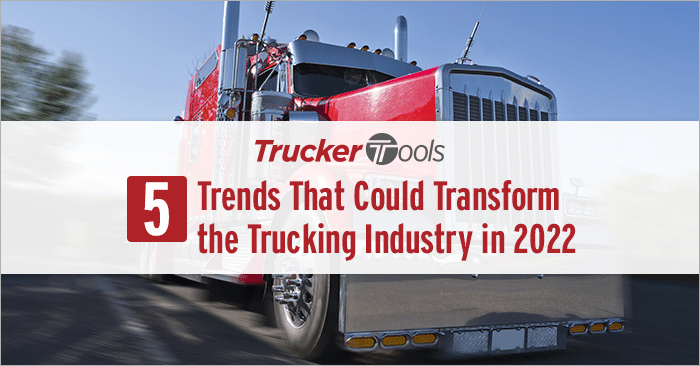With 2021 almost in the rearview mirror, it’s a good time to reflect on some of the biggest trends in trucking of the last year — and what a year it’s been! Demand for truck capacity hit historic highs, as did rates in 2021. Of course it wasn’t all good news for truckers this year, as operating costs also increased this year, which in some cases offset revenue gains for owner operators and fleets like you. None of us can predict exactly what 2022 will be like for the trucking industry, but some of the trends from 2021 no doubt are going to carry on into 2022 and beyond. In this blog, we look at how some of the biggest trends from 2021 could impact your business in the new year.
Here are five trends that could transform the trucking industry in 2022.
1. Rising Fuel Cost
The current national average per gallon price of diesel fuel is at $3.674, which is $1.148 higher than it was a year ago. Diesel prices have steadily risen after hitting a low of $2.39 in October of 2020. At the beginning of the pandemic in early 2020, there was reduced demand for fuel and oil production slowed down. Since then, demand for fuel has increased considerably and production still hasn’t caught up to meet that demand. Most experts predict that oil production will catch up to demand in 2022 and that diesel prices will fall as a result. If that doesn’t happen and diesel prices continue to climb, that will push freight rates higher and may cause more fleets to consider electric trucks and other alternatives.

2. In-App/Digital Load Booking
In a recent Trucker Tools survey of owner operators and carriers like you, it was revealed that 76 percent of you have booked at least one load within the last 60 days through an app or online. Also of note, 64 percent of those we surveyed said that five years from now, most loads will be booked online or though apps. In-app and online load booking is a part of the industry now and it’s likely to grow in 2022. App-based and online load booking tools like Trucker Tools’ Book It Now® offer you convenience and greater efficiency. Book It Now® reduces the number of phone calls you receive from brokers and helps you run a more productive trucking business, whether you’re an owner op or a fleet owner.
3. Even Higher Freight Volume
According to the American Trucking Association’s U.S. Freight Transportation Forecast to 2022, the U.S. is likely to see a 24 percent increase in freight tonnage in 2022. The good news is that revenue is predicted to increase by 67 percent as a result, and most of those gains will occur within the trucking industry. While higher freight volumes are good for you as a driver or carrier, it will put added pressure on the trucking industry. In response to higher freight volumes, it’s likely that the use of time-saving technology among owner operators and carriers like you will increase. Efficiency-boosting trucking tech like the Trucker Tools driver app and free carrier platform simplify how you find and book loads, reduce phone calls and emails from brokers, and increase productivity.

4. Shorter Hauls Gain More Popularity
Data gathered by the American Transportation Research Institute in its 2021 Analysis of the Operational Costs of Trucking found that 69 percent of the hauls made by carriers in 2020 were under 500 miles. Over the last five years, hauls over 1,000 miles have dropped. If this trend continues at the same pace, local hauls will become the primary haul length for most carriers in 2022. Unlike OTR trucking, shorter hauls allow drivers to be home more and keep drivers from sitting too long, which can be a health risk. Should the popularity of short hauls grow in 2022, it’s likely that trucking companies like yours will be challenged to find OTR drivers for longer trips.
5. Industry-Wide Focus on Reducing Detention
As an owner operator or carrier, you already know that detention is a problem for trucking. Just how big of a problem it is recently came to light in testimony that MIT researcher David Correll provided to U.S. lawmakers at a Congressional hearing. Correll told members of Congress that approximately 40 percent of a trucker’s day is being wasted on detention. He also testified that most truckers only spend six and a half hours each day moving loads, even though 11 hours are allowable under HOS regs. An industry-wide focus on reducing detention is needed to tackle the problem. If more brokers, shippers and 3PLs used technology (like Trucker Tools’ detention alerts) to monitor detention times in 2022, detention could be reduced — which would be a win for the entire industry.
Read Four Facts About Trucking, Sustainability and Electric Trucks to learn more about what e-trucks can offer the trucking industry. To download the Trucker Tools driver app, visit https://www.truckertools.com/carriers/. To start using Trucker Tools’ free carrier software platform, visit https://bookaload.truckertools.com/.






